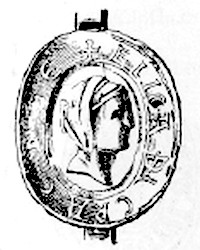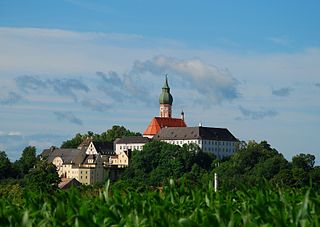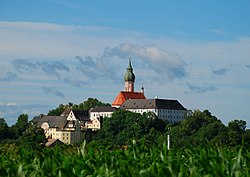
Ettal Abbey is a Benedictine monastery in the village of Ettal close to Oberammergau and Garmisch-Partenkirchen in Bavaria, Germany. With a community of more than 50 monks, with another five at Wechselburg, the Abbey is one of the largest Benedictine houses and is a major attraction for visitors.

Tegernsee Abbey is a former Benedictine monastery in the town and district of Tegernsee in Bavaria. Both the abbey and the town that grew up around it are named after the Tegernsee, the lake on the shores of which they are located. The name is from the Old High German tegarin seo, meaning great lake.

Scheyern Abbey, formerly also Scheyern Priory, is a house of the Benedictine Order in Scheyern in Bavaria.

Benediktbeuern Abbey is an institute of the Salesians of Don Bosco, originally a monastery of the Benedictine Order, in Benediktbeuern in Bavaria, near the Kochelsee, 64 km south-south-west of Munich. It is the oldest and one of the most beautiful monasteries in Upper Bavaria. It was badly damaged in an extreme weather event in 2023.

Weissenohe Abbey was a Benedictine monastery in Weissenohe in the district of Forchheim in Bavaria, Germany.

Weltenburg Abbey is a Benedictine monastery in Weltenburg near Kelheim on the Danube in Bavaria, Germany.

Weihenstephan Abbey was a Benedictine monastery in Weihenstephan, now part of the district of Freising, in Bavaria, Germany. Brauerei Weihenstephan, located at the monastery site since at least 1040, is said to be the world's oldest continuously operating brewery.

Berthold IV, a member of the House of Andechs, was Margrave of Istria and Carniola. By about 1180/82 he assumed the title of Duke of Merania, referring to the Adriatic seacoast of Kvarner which his ancestors had conquered in the 1060s and annexed to Istria and Carniola.

Andechs is a municipality in the district of Starnberg in Bavaria in Germany. It is renowned in Germany and beyond for Andechs Abbey, a Benedictine monastery that has brewed beer since 1455. The monastery brewery offers tours to visitors.

Johann Baptist Straub was a German Rococo sculptor.

The House of Andechs was a feudal line of German princes in the 12th and 13th centuries. The counts of Dießen-Andechs obtained territories in northern Dalmatia on the Adriatic seacoast, where they became Margraves of Istria and ultimately dukes of a short-lived imperial state named Merania from 1180 to 1248. They were also self-styled lords of Carniola.

Berthold III, a member of the Bavarian House of Andechs, was Margrave of Istria from 1173 until his death.

Saint Rasso of Andechs was a Bavarian count and military leader, pilgrim, and saint. He was the count (Graf) of Dießen-Andechs, leading the Bavarians against invading Magyars in the tenth century. No contemporary Vita of Rasso has survived and various legends arose around his cult in the late Middle Ages. However, there is no reason to doubt that there existed a count named Rasso who fought against the Magyars in the 950s.

Mechtildis of Edelstetten, also known as Mechtildis of Diessen or Mechtildis of Andechs, was a Benedictine abbess and, according to legend, a renowned miracle worker. Mechtildis was the daughter of Count Berthold of Andechs, whose wife, Sophie, founded a monastery on their estate at Diessen, Bavaria, and placed their daughter there at the age of five. In 1153, the Bishop of Augsburg placed her as Abbess of Edelstetten Abbey. Mechtildis was known for her mystical gifts and miracles. She died at Diessen, Germany, on 31 May 1160. Her adorned remains lie in a glass shrine within the Marienmünster church of that town.

Heilika of Pettendorf-Lengenfeld was by marriage Countess Palatine of Bavaria.

Berthold II of Andechs, a member of the House of Andechs, was a German nobleman. He was a ruling count of Dießen and Andechs in the Duchy of Bavaria, of Plassenburg and Kulmbach in Franconia, as well as bailiff of Benediktbeuern Abbey.

The Klosterbrauerei Andechs is a monastic brewery in Andechs, Upper Bavaria, Germany, well known for its Andechser beers. The brewery is run by the monks of Andechs Abbey, a priory of St. Boniface's Abbey, a Benedictine abbey situated 40 km away in Munich. It is the only monastic brewery in Germany that brews Bock beer year-round for nationwide distribution.

Henry II, Margrave of Istria, born c.1175 and died 18 July 1228 in Slovenj Gradec (Windischgraz), was a noble from the House of Andechs who ruled the March of Istria and Carniola from 1204 to 1228. He inherited the County of Stein, and expanded his domains to the Windic March through marriage. He died childless, and his vast possessions were eventually inherited by his niece Agnes of Merania.

The Duchy of Merania was a fiefdom of the Holy Roman Empire from 1152 until 1248. The dukes of Merania were recognised as princes of the Empire enjoying imperial immediacy at a time when these concepts were just coming into use to distinguish the highest ranks of imperial nobility.

Klostergasthof Andechs is a monastery restaurant in Andechs Abbey, Bavaria, Germany.























